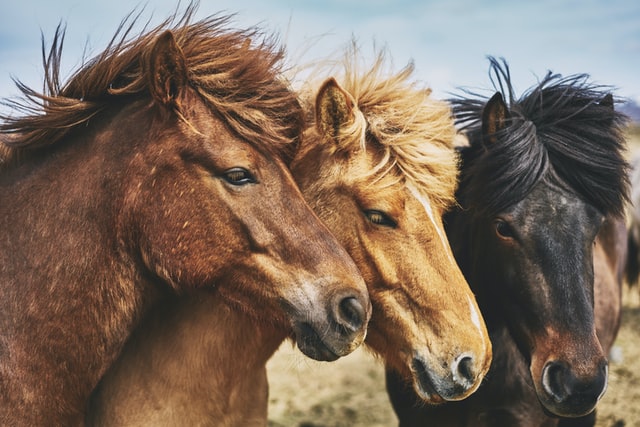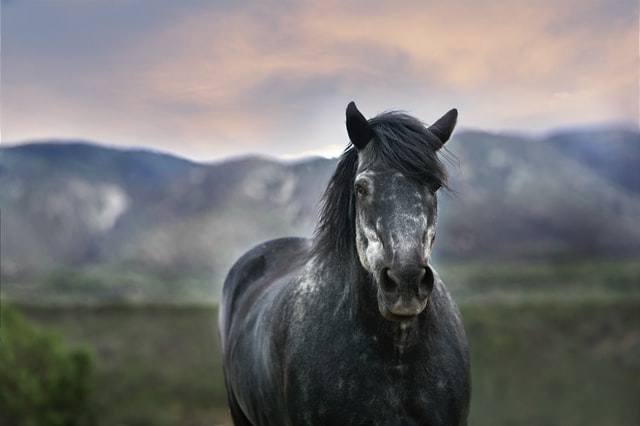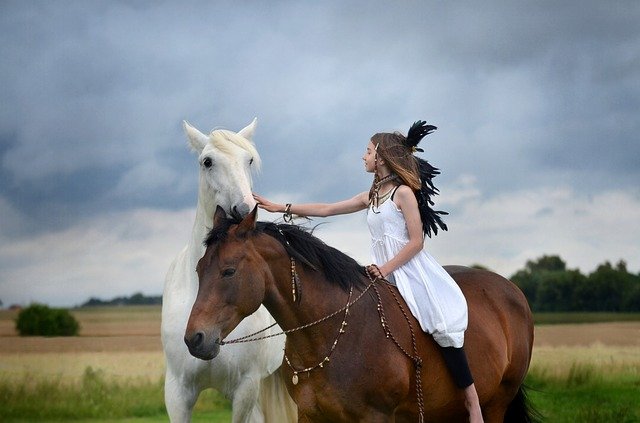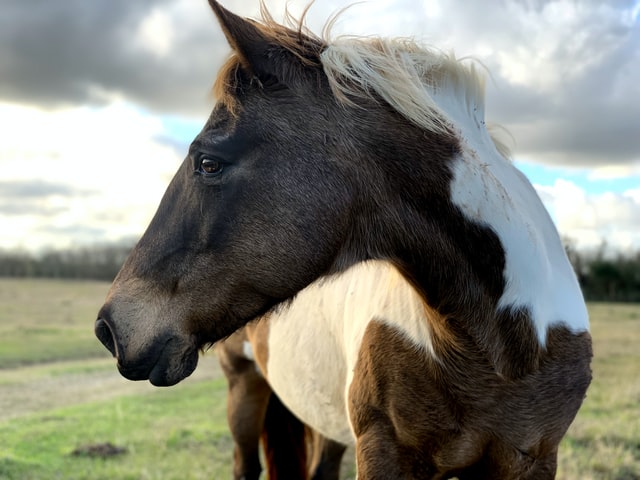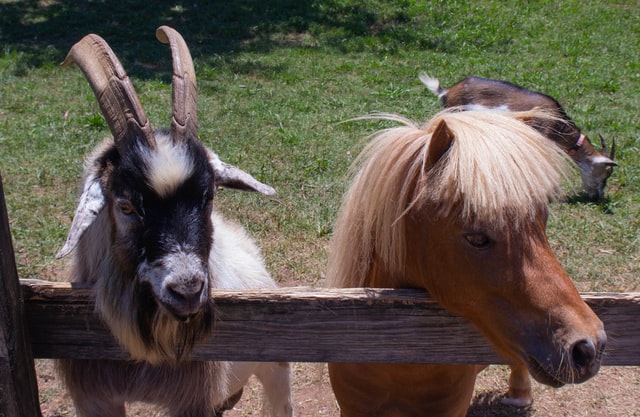Beginner Horse Terms You Need to Know
Whether you’re a horse lover, take lessons, or are looking to buy your first horse, these 141 horse terms will help you talk the talk, as well as walk the walk.
Learning the lingo around any industry or sport is a lot like learning how to navigate a map.

Suddenly you have an understanding of the lay of the land and can navigate this new world with the people who live in it.
Learning horse terms can take years – reading the books, being exposed to the terms in context, hearing them, not knowing what they mean, and then looking them up late
r. It can all be very frustrating.
So to speed up the process I’ve gathered the top horse terms that you should know to be able to talk the talk.
If you’ve like, create a set of quizlet cards to practice in your down time!
Horse Terms You Need to Know
A
Action – the way a horse moves, often used to describe how high a horse lifts his knees and hocks while moving
Aids – the way we tell a horse what to do. There are four primary aids: hand, legs, seat and voice.
Appaloosa – a breed of spotted horse developed by Native Americans. It’s said that their spots helped them be camouflaged under spotted sunlight in forests.
Appy – a nickname for an Appaloosa
Arab – a nickname for an Arabian (see below)
Arabian – one of the oldest breeds of horse, Arabians were developed in the Arabian Peninsula. Known for their thin legs, dished face and erect tail, they excel at endurance sports.
B
Balk – when a horse does not move forward or respond to the rider’s aids, usually out of fear.
Barn sour/Buddy sour – when a horse becomes nervous and unruly when away from the barn/buddy and rushes back.
Bars – the part of a horse’s jaw that does not have teeth and where the bit (see below) rests.
Bay – a color classification of horse indicative of brown body and black mane and tail.
Billets – the leather straps on an English saddle where the girth attaches.
Bit – the metal mouthpiece that sits on the bars of the horse’s mouth and from which hand aids are communicated and interpreted.
Blaze – a face marking noted by a large, white swath running down the horse’s nose from above the eyes to the nostrils.
Blemish – a scar or defect that is left over after an injury or disease.
Blue roan – a coloring indicated by a black base coat of hair with white and grey speckled throughout.
Break – to break a horse is to train it to ride.
Breed show – a competition in which the contestants must all be one breed of horse.
Broke (Broke to ride) – a horse that is well trained to ride.
Brood mare – a female horse used specifically for breeding.
Buck – the motion a horse does when he kicks up both hind legs. Often this is a rocking motion where the front end and hind end alternate coming up. Usually caused by joy, or the desire to remove the rider from his back.
C
Canter – a three-beat gait faster than a trot, but slower than a gallop.
Cantle – the rear part of the saddle.
Chestnut (2) – there are two meanings to ‘chestnut’. First is a reddish-brown horse whose mane and tail is the same color as their coat. The second meaning is a scabby patch on the inside of all four legs that is the remnant of ancient horse’s thumb appendage.
Cinch – the girth or strap that goes around the horse’s belly that secures the saddle in a western tack.
Coggins – a blood test that tests for Equine Infectious Anemia (EIA). A negative coggins is needed for crossing state lines, showing, and most of the time for sales.
Colic – a term that means generic stomach pain. Horses cannot throw up, so colic could be caused by many different causes, but is the state of stomach pain.
Colt – a young, intact, male horse.
Competitive trail riding – a competition of how well trained your horse is when encountering extreme trail conditions.
Condition – fitness state of the horse. Also their weight state.
Conformation – the study of how the angles of a horse’s bones influence their musculature and function. Also, the horse’s overall composition.
Coronet band – the skin and fleshy part just above the hoof.
Crest – the top of a horse’s neck, where the mane grows from.
Cribbing – an act of chewing on wood as a comforting mechanism. Often caused by stress.
Crop – a shortened whip, used to reinforce the leg aids.
Croup – the top portion of a horse’s hind leg, from the beginning of their pelvis to the top of the tail.
Cutting horses – a mounted discipline of separating a cow from the herd.
D
Dam – a horse’s mother.
Dapple – a coat pattern marked by spots or rounded patches. Often grey, but can also be brown.
Dewormer – a medication, usually a paste or powder, designed to kill internal parasites.
Diagonal – when opposite pairs of feet hit at the same time, for example, at the trot.
Dock – the upper part of the tail.
Dorsal stripe – a darker colored stripe along the spine of the horse.
Draft – a category of breeds that are larger and heavier, designed for plowing or pulling a cart.
Dressage – the discipline of riding very correct movements with the horse.
Dun – a light brown coat color, usually accompanied by a darker dorsal line and legs.
E
Endurance riding – a mounted sport consisting of traveling over many miles as efficiently as possible.
English – the set of tack used in sports such as jumping and dressage.
Equine – scientific name for horse.
Equitation – the art of riding and horsemanship. Specifically the rider’s position while mounted. Also, there are equitation shows that judge the rider’s position rather than the horse’s performance.
Equestrian – anyone who deals with/rides/trains horses.
Eventing – a horse sport comprised of three events: a cross-country jumping phase, an arena jumping phase and a dressage phase.
F
Farrier – a professional who takes care of your horse’s feet by either barefoot trimming, or shoeing.
Feathers – the hairs around the fetlocks (see below) of heavier breeds.
Fetlock – the joint just above the hoof.
Filly – a young female horse.
Flank – the area of the horse’s body between the ribs and hind leg.
Flying lead change – when a horse is cantering, one front leg lands in front of the other – a lead. A flying lead change is when a horse changes his lead without breaking stride in a skipping like motion.
Foal – a baby horse of any gender.
Forlock – the bit of hair or mane that comes out front between the ears and lays on the forehead.
Frog – the fleshy, triangular part of a horse’s hoof.
Founder – a metabolic condition that can cause separation of the internal lamina (hoof) to the external lamina (hoof).
G
Gaits – the different ways of going for a horse. Walk, trot, canter and gallop are gaits.
Gaited horse – a gaited horse is a breed that has a unique gait (see above) that is a four-beat gait faster than a walk but slower than a canter.
Gaskin – the large muscle on the horse’s hind leg between the stifle and the hock.
Gallop – the fastest gait a horse can do.
Gelding – a castrated male horse.
Girth – the piece of equipment that goes around the horse’s ribs and secures the saddle. Also – the area of the horse’s belly that the girth goes around.
Grade horse – a horse whose parentage is unknown or significantly mixed.
Green – a young, inexperienced horse.
Ground work/ground training – the training of a horse where the trainer is on the ground. Namely for safety, and relationship building.
Gymkhana – a mounted sport consisting of speed pattern racing and timed games.
H
Hackamore – a headpiece that does not have a bit and which works off of pressure.
Hand – a measurement of a horse’s height at the withers. One hand equals 4 inches.
Hunter/hunter class – a sport consisting of jumping where the aim is for the horse to appear easy to jump.
I
Irons – another name for the stirrup irons.
J
Jog – slower than a trot, designed to be a more comfortable gait.
Johdpurs – tight-fitting pants designed for riding.
Jumper class – a sport consisting of jumping a course as quickly as possible.
K
L
Laminitis – an inflammatory disease of the hooves that is very painful.
Light horse – any breed of horse used primarily for riding or light work with a lighter body build.
Lead: two meanings – 1. a nickname for lead rope (see below), and 2. the leading leg of the horse at a canter or gallop.
Lead-line class – a type of show with young riders where an adult leads them through the show.
Lead rope – a flat line or rope attached to the halter used for leading the animal.
Leading rein – the inside rein.
Leg up – the act of a person on the ground acting as a brace for the rider to mount on.
Loafing shed – also called a run-in shed or run-in, it is a three-sided structure in a field or paddock used for shelter.
Lope – a slow, easy canter performed by Western horses.
Longe/Lunge – the act of the horse moving around the trainer in a circle. Used for training and exercise.
M
Mare – a female horse.
Markings – the distinguishing characteristics on a horse’s coat, such as on his legs and face.
Martingale – a piece of equipment that runs from the noseband to the horse’s girth to prevent him raising his head too high.
Morgan – a breed originating in Vermont, known for their sturdiness and active gaits.
Mucking out – to clean out the manure and dirty bedding from a stall.
N
Navicular bone – a small, rounded bone just behind the coffin bone, the very last bone in a horse’s leg, surrounded by the hoof.
Navicular disease – a disease that damages the navicular bone of the horse.
Nearside – the horse’s left side. (As if you were the horse, or were on top of the horse).
O
Offside – the right side of the horse as if you were on top of the horse.
P
Paddock – a fenced enclosure where horses are kept.
Paint – a breed of horse known for it’s two-toned body color (white patches and areas over the base color).
Palomino – a coloring distinguished by a tan body color and white mane and tail.
Pastern – the section of a horse’s leg between the hoof and the fetlock.
Pinto – a coloring distinguished by two-color coat. A pinto can be any breed, whereas a Paint shares the same coloring but is a specific breed.
Pleasure riding – riding for pleasure, not showing. However, there is are competitions called “Pleasure”, where the horse’s smoothness and ease of going are judged.
Pole bending – a timed event where contestants must weave in and out of a line of poles.
Poll – the place between a horse’s neck and head, just between the ears.
Pommel – the front part of the saddle.
Pony – any horse that measure 14.2 hands or shorter.
Posting – the act of rising and sitting again at the trot to facilitate the horse’s movement.
Pre-purchase exam – an exam performed by a vet before the purchase of a horse with the goal of identifying any physical issues that may prevent the horse from performing the desired job.
Pulling back – a frantic backing up by a horse, usually when tied, as a result of fear.
Q
Quarter horse – a popular breed primarily bred for short racing (a quarter of a mile) and cattlework. However, this breed has quickly gained popularity for their hardiness and personality.
R
Racing – a sport in which many horses run a specific distance to see who gets their first.
Rearing – the act when the horse rises up on only his back legs.
Reining – a Western event in which horses and riders perform a predetermined set of actions for a judge.
Roping – a Western sport that involves roping a calf.
Round pen – a circular enclosure used for training.
Run-in – a three-sided building in a field used for shelter.
S
Saddlebred – a breed developed in the United States know for their asethic and style of movement.
School horse – a horse used to give riding lessons; usually very well trained.
Schooling show – a “practice” show for novice riders and advanced rider introducing green horses to the showing world.
Showing – competing for money or ribbons.
Show jumping – a competition in which the horse that completes a course of jumps cleanly and the fastest win.
Shying – when a horse jumps in fright.
Stallion – an intact, adult male horse.
Stud – a stallion used for breeding.
Spooking – another word for shying, when a horse reacts in fear.
T
Tack – the equipment used when riding a horse.
Tacking up – putting the tack (see above) on a horse in preparation for riding.
Tennessee walker – a breed of horse known for their additional four-beated gait.
Thoroughbred – a breed of horse designed for racing.
Transition – changing between gaits, for example the halt to the walk, the walk to the trot, etc.
Trot – a two-beat gait where the diagonal pairs of legs move forward at the same time.
Turn out – letting the horse rest and relax outdoors.
U
Uveitis – a disease that causes a gradual loss of vision in a horse.
V
Vaulting – a sport that has been called “gymnastics on horseback” where riders perform gymnastic exercises on horseback.
Vice – any unwanted behavior, usually a result of stress.
W
Warmblood – a descriptive word for many different middle-weight horse breeds.
Welsh pony – a breed of pony developed in the hills and valleys of Wales.
Withers – the bony point between the horse’s neck and back.
Worms – parasites that can make a horse sick.
X
Y
Yearling – A horse that is a year old.
Z
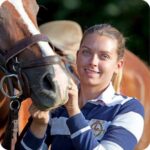
Lauren is an internationally published author, trainer, and has helped hundreds of horse-rider combinations create lasting bonds and the success they desire. Check out Lauren’s incredible story: From horse-crazy girl to international equine educator. Or if you want to send Lauren a quick message, check out her contact page here.
